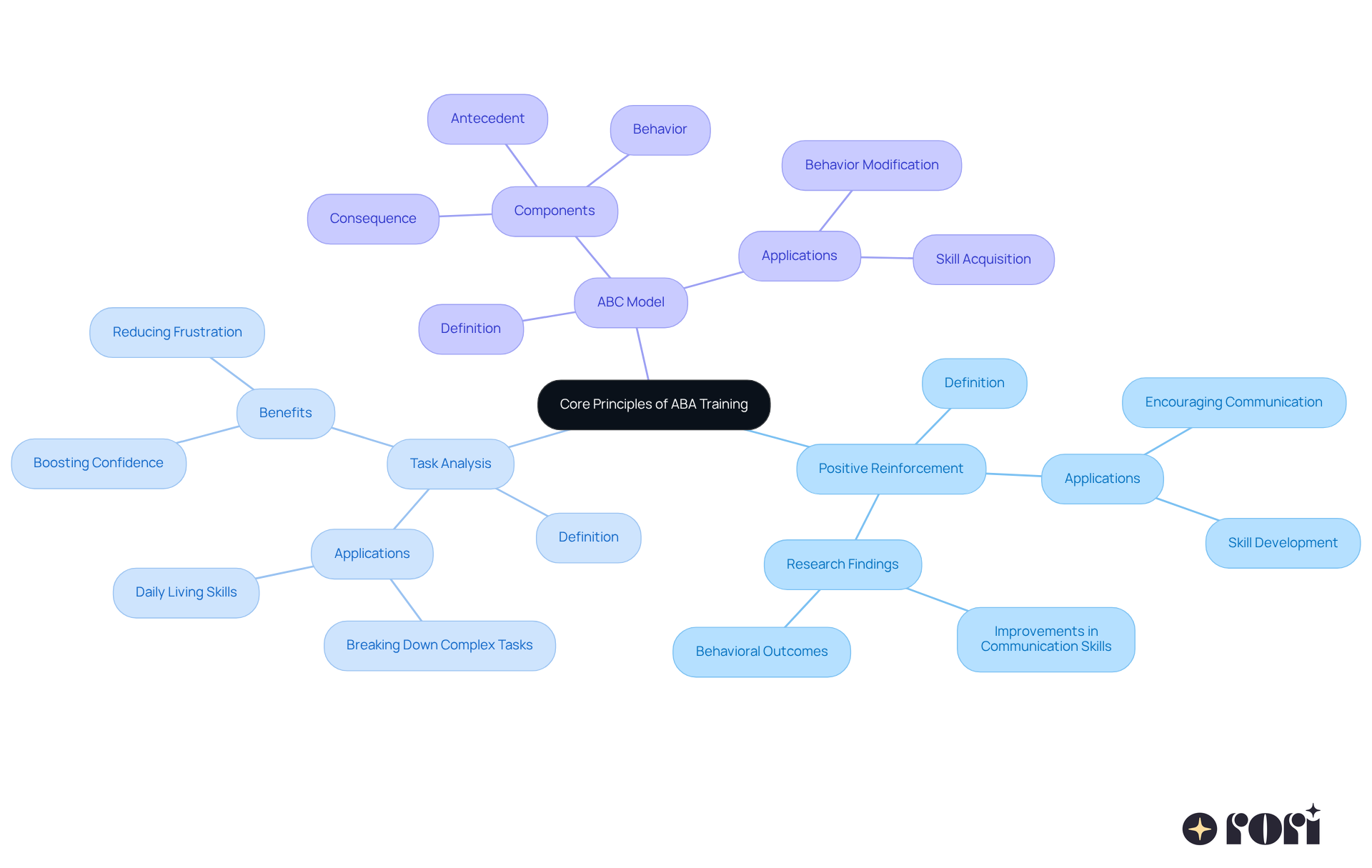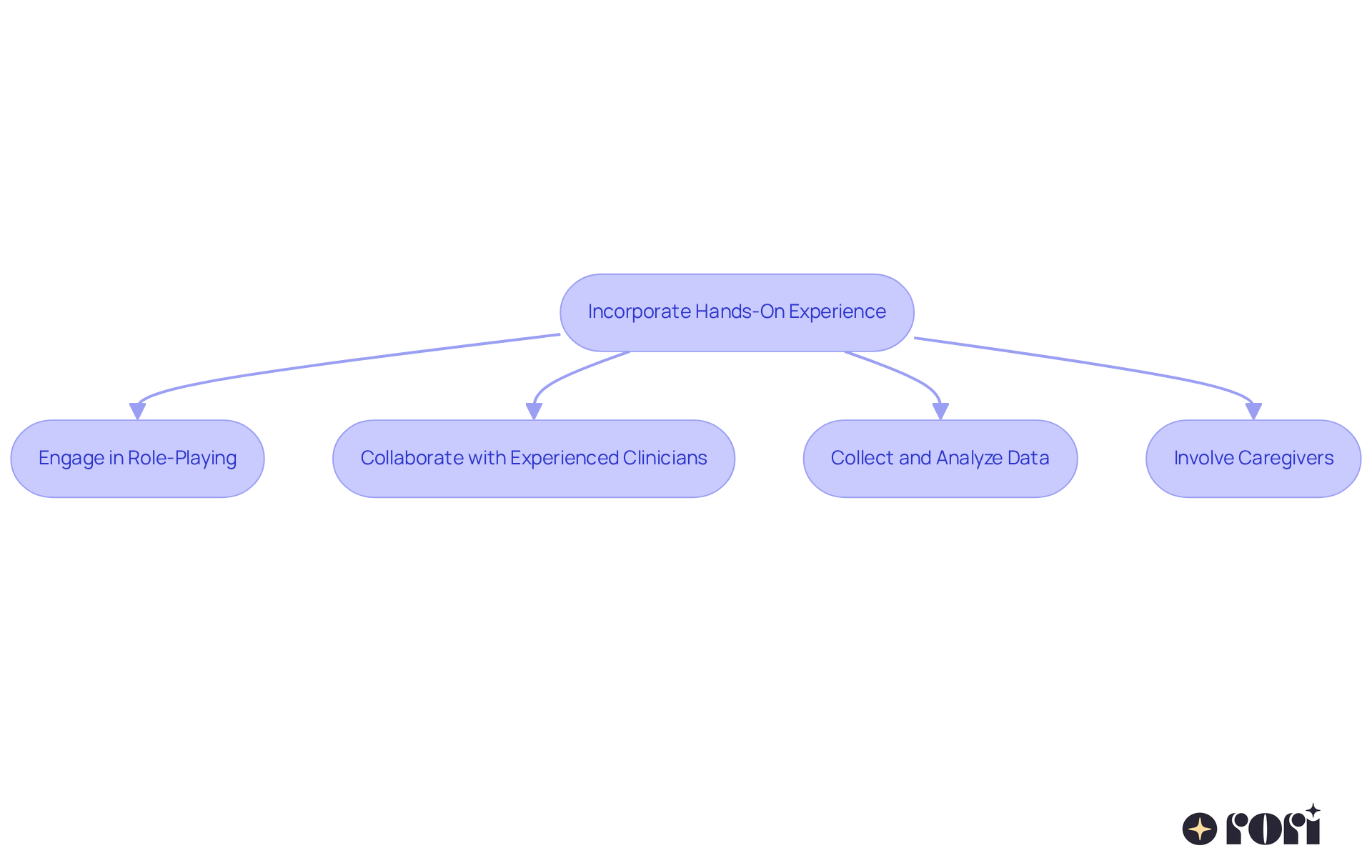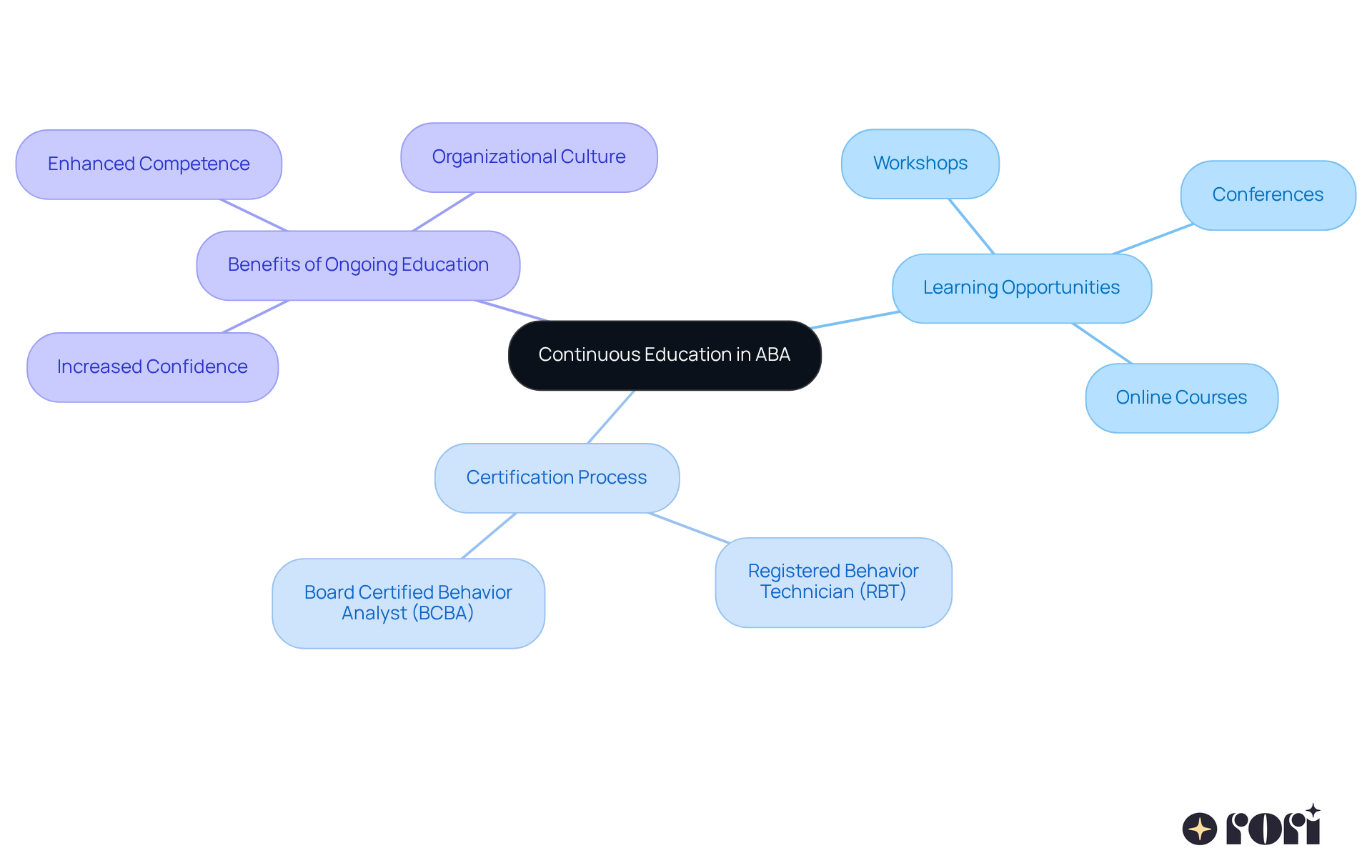This article shares four key strategies for effective ABA staff training that can really make a difference!
Together, these strategies show that a solid grasp of ABA principles, practical training, ongoing professional development, and the smart use of technology can significantly boost staff competence. Ultimately, this leads to better outcomes for individuals with autism. Let’s explore this together and see how these approaches can help create a positive impact!
Understanding the intricacies of Applied Behavior Analysis (ABA) is essential for professionals dedicated to improving the lives of individuals with autism. By mastering core principles like positive reinforcement and task analysis, ABA staff can significantly enhance their training effectiveness and, ultimately, the outcomes for those they serve.
But as the field evolves, how can practitioners ensure they stay ahead with the best practices and innovative strategies? Let’s explore four key strategies for effective ABA staff training. We’ll dive into practical applications, ongoing education, and how integrating technology can help foster a more competent and confident workforce. Together, we can make a difference!
Understanding the Core Principles of ABA Training
Let’s dive into the core principles of Applied Behavior Analysis (ABA)! These principles include positive reinforcement, task analysis, and the ABC model (Antecedent-Behavior-Consequence). It's crucial for ABA staff training to start with a solid grasp of these concepts, as they form the backbone of all ABA interventions.
Positive Reinforcement: This is all about rewarding desired behaviors to encourage them. It plays a vital role in helping young individuals with autism develop new skills. Research shows that when positive reinforcement is used effectively, it can lead to significant improvements in communication skills and overall behavioral outcomes. Isn’t that amazing?
Task Analysis: This technique breaks down complex tasks into smaller, manageable steps. It makes learning new skills feel much easier! By simplifying the process, we can boost confidence and reduce frustration among young learners. For instance, when teaching daily living skills like dressing, a task analysis could include steps such as choosing outfits, putting on a shirt, and fastening buttons. This way, learners can master each step before moving on to the next.
Fast forward to 2025, and positive reinforcement in ABA therapy is still a big deal! Studies continue to show that it leads to remarkable improvements in adaptive skills for individuals with autism. You can see these principles in action in therapy settings, where therapists use positive reinforcement to encourage communication, like rewarding a child for using words instead of gestures to express their needs.
Additionally, qualified behavior analysts play a key role in crafting individualized plans tailored to each child's unique needs. By incorporating these fundamental ideas into ABA staff training, practitioners can effectively implement personalized treatment strategies, ultimately enhancing developmental outcomes.
Moreover, incorporating measurable goals and ongoing assessments into development ensures that staff can track progress and make necessary adjustments. This flexible approach, rooted in evidence-based strategies, empowers caregivers with the knowledge and skills they need to support their children effectively. It really highlights the importance of early intensive behavioral intervention (EIBI) in improving learning, verbal, and social skills in children with autism.
We’re here to help you every step of the way! Let’s explore these principles together and see how they can make a difference in your child’s journey.

Integrating practical experience into ABA personnel development programs is so important for effective learning! Role-playing and simulations, along with supervised practice sessions, are fantastic tools in this journey. For example, trainees can practice implementing behavior intervention plans in controlled environments. This allows them to get immediate feedback and make necessary adjustments, which is super helpful!
Observing seasoned clinicians during therapy sessions adds even more value to this learning experience. It offers invaluable insights into effective techniques and strategies. Studies show that employees who engage in practical instruction feel a boost in their confidence and can use their knowledge in real-life situations much better.
Experts agree that role-playing significantly improves results, reinforcing its role as a key part of comprehensive ABA staff training. And let’s not forget about empowering caregivers! Teaching them ABA principles and strategies not only supports their children's behavioral goals but also leads to better outcomes through their active involvement and informed decision-making.
To put these principles into action, consider these friendly steps:
Let’s explore this together! Your journey in ABA can truly make a difference!

Ongoing education and certification are super important for effective ABA staff training and development! Professionals in the field should definitely look for ongoing learning opportunities, like workshops, conferences, and online courses, to keep up with the latest in ABA staff training. A big step to becoming a qualified Registered Behavior Technician® (RBT) is passing the board exam, which checks your mastery of the RBT Task List. This certification process not only shows that ABA professionals have the skills needed but also prepares them to empower caregivers with ABA principles and strategies to support children's behavioral goals through active involvement and data collection.
Organizations like the BACB require ABA professionals to engage in ongoing professional development, underscoring the importance of ABA staff training for continuous education. For example, earning certifications like the Board Certified Behavior Analyst (BCBA) credential not only boosts a clinician's qualifications but also ensures they are up-to-date with the latest evidence-based practices. Research shows that ongoing development, such as ABA staff training, enhances therapists' confidence and competence, which really supports the case for continuous education! Encouraging employees to pursue continuing education units (CEUs) through ABA staff training helps create a culture of professional growth and commitment to excellence in service delivery.
As one motivational quote says, 'Every step forward is a step toward success.' This really highlights the importance of continuous learning in our field. So, let’s explore this together and consider how ongoing education can make a difference for you and your team!

Using technology in ABA personnel development can really boost learning outcomes! E-learning platforms, virtual reality simulations, and mobile apps provide interactive and engaging experiences that make learning fun. For example, virtual reality can mimic real-life therapy situations, allowing staff to practice their skills in a safe space.
Plus, data analytics can keep track of employee progress and highlight areas for improvement, making it easier to create personalized development plans. By incorporating technology into ABA staff training programs, organizations can ensure their teams are prepared to deliver effective interventions.
And let’s not forget about AI-powered tools! They can streamline progress monitoring and reporting, freeing up 50% more time for treating youth. This not only makes therapy more efficient but also equips caregivers with essential ABA principles and strategies. Ultimately, this benefits the children and families they work with. Let’s explore this together and see how technology can enhance our approach to ABA!

Effective ABA staff training is truly essential for delivering high-quality interventions and achieving positive outcomes for individuals with autism. By embracing the core principles of Applied Behavior Analysis, integrating hands-on experiences, emphasizing continuous education, and leveraging technology, organizations can develop robust training programs that empower staff and enhance their skills.
The article highlights key strategies that are crucial for effective training. Starting with a solid understanding of ABA principles, like positive reinforcement and task analysis, lays the groundwork for successful interventions. Incorporating practical experiences through role-playing and supervised practice allows trainees to apply their knowledge in real-world scenarios. Continuous education ensures that professionals stay competent and informed about the latest practices, while technology makes learning engaging and helps track progress efficiently.
In conclusion, the importance of effective ABA staff training is immense. It not only equips professionals with the necessary skills but also nurtures a culture of growth and excellence in service delivery. By prioritizing these strategies, organizations can significantly impact the lives of children and families, ultimately promoting better developmental outcomes. Embracing these practices will pave the way for a brighter future in ABA therapy, ensuring that every child receives the support they need to thrive. Let’s explore this together and make a meaningful difference!
What are the core principles of Applied Behavior Analysis (ABA) training?
The core principles of ABA training include positive reinforcement, task analysis, and the ABC model (Antecedent-Behavior-Consequence). These concepts are essential for effective ABA interventions.
How does positive reinforcement work in ABA?
Positive reinforcement involves rewarding desired behaviors to encourage their occurrence. It is particularly effective in helping individuals with autism develop new skills and improve communication abilities.
What is task analysis in the context of ABA?
Task analysis is a technique that breaks down complex tasks into smaller, manageable steps. This simplification helps learners build confidence and reduces frustration when acquiring new skills, such as daily living tasks.
What impact does positive reinforcement have on individuals with autism?
Research indicates that effective use of positive reinforcement in ABA therapy leads to significant improvements in adaptive skills, communication, and overall behavioral outcomes for individuals with autism.
How do qualified behavior analysts contribute to ABA training?
Qualified behavior analysts create individualized plans tailored to each child's unique needs, incorporating core ABA principles to implement personalized treatment strategies that enhance developmental outcomes.
Why is ongoing assessment important in ABA training?
Ongoing assessments and measurable goals allow staff to track progress and make necessary adjustments in treatment plans. This evidence-based approach ensures caregivers are equipped to support their children effectively.
What is the significance of early intensive behavioral intervention (EIBI)?
EIBI is crucial for improving learning, verbal, and social skills in children with autism, highlighting the importance of implementing ABA principles early in a child's development.